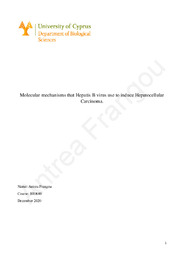Molecular mechanisms that Hepatitis B virus uses to induce Hepatocellular Carcinoma

View/
Date
2020-12-07Author
Frangou, AntreaAdvisor
Charalampous, AnnaPublisher
Πανεπιστήμιο Κύπρου, Σχολή Θετικών και Εφαρμοσμένων Επιστημών / University of Cyprus, Faculty of Pure and Applied SciencesPlace of publication
CyprusGoogle Scholar check
Keyword(s):
Metadata
Show full item recordAbstract
Hepatitis B is an infectious liver disease caused by the Hepatitis B virus (HBV). HBV is a small DNA virus that mainly affects hepatocytes, which are the main liver cells, and it has the ability to replicate by reverse transcription. It can cause both acute infection, which lasts less than 6 months, or chronic infection which lasts more than 6 months. Most of the times newly infected patients do not develop any symptoms, depends on the ability of the host’s immune system and their general health. However, some of the most common symptoms are jaundice, dark urine, abnormal abdominal pain, vomiting, and fatigue. Chronic HBV infection can cause severe complications such as liver cirrhosis or even liver cancer, called hepatocellular carcinoma (HCC). Hepatitis B virus can be transmitted through blood or any other body fluids and from mother to child during birth. Since 1982 the HBV infection has been preventable by vaccination. Other prevention measures are the use of condoms during any type of sexual activity, all the blood to be tested for HBV before transfusion. In patients with chronic infection, there are antiviral medications for example tenofovir interferon and even liver transplantation is also used in patients with severe liver damage (cirrhosis). The molecular mechanisms of are still not well understood. However, many studies showed that one of the most important causative factors for carcinogenesis is the viral protein HBx. HBx protein is a multifunctional protein and it plays a vital role in viral replication. HBx regulates the expression of many important cellular and viral genes which are involved in cell survival (apoptosis), cell replication, DNA repair, and protein degradation. It also modulates several signaling pathways including Ras/Raf/MAPK, PI3K/Akt, NFκB, and JNK. This review will summarize the important mechanisms of HBx-induced hepatocellular carcinoma (HCC), as well its potential use in new therapeutic strategies against the HBV infection.
